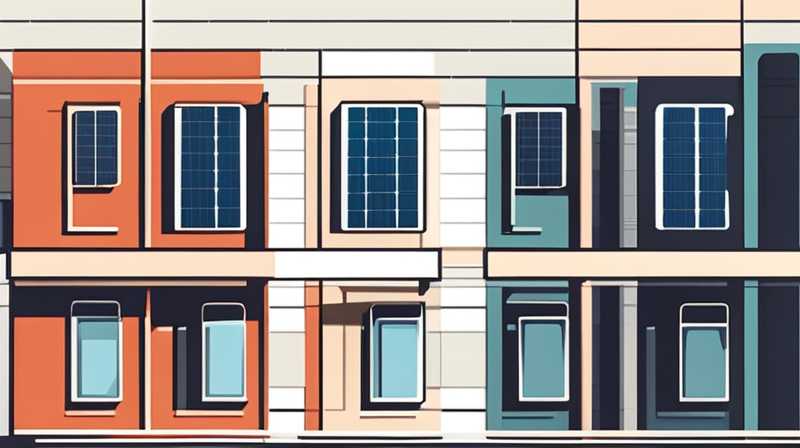
1. To effectively utilize solar panel brackets outside a building, careful consideration of installation, alignment, and maintenance is essential. 2. Choosing the right type of bracket based on the panel specifications and roof type is crucial. 3. Proper orientation towards the sun enhances efficiency and energy production. 4. Regular inspection and tweaks in positioning can optimize solar panel performance.
1. UNDERSTANDING SOLAR PANEL BRACKETS
Solar panel brackets are pivotal components for securing photovoltaic (PV) modules to various surfaces. The design of these brackets dictates the effective utilization of solar panels by maintaining optimal angles and positions to maximize sun exposure. Different types of solar panel brackets include fixed mounting systems, adjustable racks, and ground mounts. Each type serves specific purposes depending on the installation environment, such as rooftops, open land, or even building facades.
The selection of a suitable bracket system is profoundly influenced by the constraints and architectural features of the building. For instance, sloping roofs may necessitate different mounting brackets than flat surfaces. Additionally, the orientation of the solar panels—whether pitched towards the roof or elevated on ground mounts—determines how efficiently the panels can collect solar energy throughout the day. Understanding these factors lays the groundwork for an optimal solar energy setup.
2. TYPES OF SOLAR PANEL BRACKETS
A comprehensive understanding of the various types of solar panel brackets reveals their unique functionalities depending on the installation scenario. There are several categories of brackets each tailored for distinct applications. Flat roof mounts, for example, help secure the panels on buildings with a flat rooftop. They often involve lower profiles and substantial ballast to prevent dislodgement from wind forces.
In contrast, roof mounting systems are adaptable to pitched roofs, allowing solar panels to align correctly with the sun’s path. The tilt angle can also be adjusted to enhance energy capture, especially in regions where solar intensity varies across seasons. Each bracket type is designed to withstand environmental conditions such as wind, snow load, and temperature fluctuations. Understanding the nuances between these bracket types is vital for anyone considering solar energy as a viable option.
3. INSTALLATION PROCEDURE
Effective installation begins with proper planning. Before placing any solar panel brackets outdoors, evaluate the roof’s structure and strength. A professional assessment might reveal potential weaknesses or areas unsuitable for mounting solar panels. Once you choose the desired bracket type, follow these general steps to install them adequately.
1. Measure the installation area. Utilizing measuring tools can help ascertain the precise location and ensure proper spacing between panels. 2. Mark the drill points. When the layout is clear, mark where the brackets will attach; proper alignment facilitates a cleaner installation. Drill holes based on the manufacturer’s specifications to prevent misalignment.
Furthermore, attaching brackets can involve using appropriate fasteners that are corrosion-resistant, especially in coastal areas where saltwater exposure is prevalent. After fixing the brackets securely, place the solar panels onto the mounts and lock them in place. This systematic approach ensures a stable installation that can withstand the elements.
4. OPTIMIZING SOLAR PANEL PERFORMANCE
The alignment and positioning of solar panels play a crucial role in their energy production capacity. Factors such as latitude, installation angle, and azimuth must be considered. A south-facing orientation is generally optimal in the Northern Hemisphere, while north-facing might be more effective in the Southern Hemisphere. Ensuring that no obstructions block sunlight throughout the day is essential.
Additionally, periodic maintenance post-installation is vital to sustain performance. This entails cleaning the panels regularly to remove dust, debris, and occasional bird droppings. Ensure that brackets remain intact without signs of rust or damage. This vigilance not only prolongs the lifespan of the solar installation but also optimizes energy output.
FAQs
WHAT FACTORS SHOULD I CONSIDER BEFORE INSTALLING SOLAR PANEL BRACKETS?
Prior to installation, consider various elements such as the roof type, structural integrity, local climate conditions, and regulations within your jurisdiction. The roof’s angle and orientation are significant because these determine how much sunlight the panels collect. Additionally, it’s imperative to evaluate the weight the roof can support, particularly for systems requiring ballast on flat roofs. Familiarity with local laws governing solar installations is also essential, as some areas have strict guidelines that must be adhered to. Researching suitable types of brackets designed for your specific environment ensures a lasting solar panel system.
HOW DO I MAINTAIN SOLAR PANEL BRACKETS?
Routine maintenance of solar panel brackets focuses on ensuring their durability and functionality over time. Regularly check for signs of corrosion or wear, particularly around connection points and fasteners. Cleaning the panel surfaces should also be part of your maintenance routine, as dirt and grime can significantly decrease energy efficiency. Inspect the brackets and mounting hardware for depressions or other damages that might affect alignment. If you notice any signs of instability or disrepair, it’s advisable to consult a professional for repairs. Proper maintenance can help prolong the lifespan of your solar installation.
CAN SOLAR PANELS BE INSTALLED ON ALL ROOFTOPS?
While many rooftops can accommodate solar panels, certain factors make some structures more suitable than others. For instance, rooftops with flat surfaces can utilize ballasted systems, while sloped roofs might require specific mounting solutions compatible with their steepness. Obstructions such as chimneys, antennas, or trees can significantly limit the effective use of solar panels. Additionally, roofing materials must be compatible with solar mounts to prevent leaks. It is essential to assess both the physical and structural elements of the roof before proceeding with an installation.
In summary, the utilization of solar panel brackets outside buildings necessitates meticulous planning and execution to ensure effectiveness. The selection of appropriate bracket types aligned with building characteristics, understanding installation protocols, and maintaining optimal positioning is paramount for success. By adhering to the stipulated guidelines and performing regular maintenance checks, individuals can maximize the utility and longevity of their solar panel installations. The benefits extend beyond individual households to support the broader shift towards renewable energy solutions.
Original article by NenPower, If reposted, please credit the source: https://nenpower.com/blog/how-to-use-the-solar-panel-bracket-outside-the-building/


